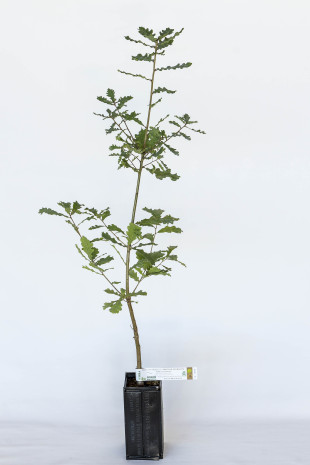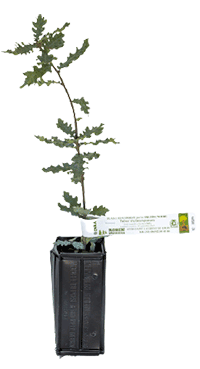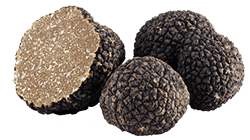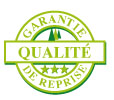


 Young truffle plant of Pubescent Oak (Quercus pubescens) mycorhized with tuber uncinatum. Pubescent Oak intended for the production of Burgundy truffles. Truffle oak plant aged from 1 to 3 years, produced in France with certified quality under INRAE control.
Young truffle plant of Pubescent Oak (Quercus pubescens) mycorhized with tuber uncinatum. Pubescent Oak intended for the production of Burgundy truffles. Truffle oak plant aged from 1 to 3 years, produced in France with certified quality under INRAE control.
Do you want to grow Burgundy truffles and are you looking for the most suitable plants for this production? Or perhaps you simply want to add new plants to your truffle orchard that will produce this famous autumn truffle appreciated for its taste? Because of its remarkable truffle-growing abilities, the pubescent oak could be the ideal truffle plant for your truffle orchard!
 This pubescent oak truffle plant is obtained after controlled and certified mycorrhization of a pubescent oak tree (Quercus pubescens) with Burgundy truffle spores (Tuber uncinatum). The tree obtained is ready to be planted in your truffle field. It will produce its first truffles within 6 to 7 years.
This pubescent oak truffle plant is obtained after controlled and certified mycorrhization of a pubescent oak tree (Quercus pubescens) with Burgundy truffle spores (Tuber uncinatum). The tree obtained is ready to be planted in your truffle field. It will produce its first truffles within 6 to 7 years.
In order to meet your expectations, our pubescent oak truffle plants, mycorhized with the Burgundy truffle, are available in 4 sizes of cups:
- in anti-chignon® R430 cup of 0.43 liters
- in anti-chignon® R600 cup of 0.6 liters
- in anti-chignon® R1.5L cup of 1.5 liters
- in R3L container (volume of 3 liters)
Present in Southern Europe and the Middle East, the pubescent oak (Quercus pubescent) is also called "white oak". It owes its name to the fuzz that covers the underside of its leaves. This variety of oak grows especially in rich, drained soils and it supports very well the presence of limestone, which makes it an interesting species from a truffle point of view. A heliophilous tree (which likes light and sun), with a very long life span and very slow growth, the Pubescent Oak grows naturally in slightly humid, clayey, limestone-rich soils. It tolerates drought relatively well and can withstand frost down to -20°C, so that it can be found at altitudes of up to 1400 m. Because of its characteristics and its biotope, the pubescent oak favors the development of truffles by its side, it is moreover the truffle oak that is regularly found in the Perigord or in the Vaucluse.
 This is likely the most common edible truffle variety in Europe. This autumn truffle is distinguished by its black exterior (peridium). Inside, the flesh is dark brown. And it is distinguished by its very present white veins. The Burgundy truffle is an edible mushroom prized for its delicate flavors. As its vernacular name suggests, the Burgundy truffle was historically found mainly in east-central France. While it has since spread very widely well beyond this region, in France, Burgundy, Champagne, and Lorraine and Alsace remain the regions favored by Tuber uncinatum.
This is likely the most common edible truffle variety in Europe. This autumn truffle is distinguished by its black exterior (peridium). Inside, the flesh is dark brown. And it is distinguished by its very present white veins. The Burgundy truffle is an edible mushroom prized for its delicate flavors. As its vernacular name suggests, the Burgundy truffle was historically found mainly in east-central France. While it has since spread very widely well beyond this region, in France, Burgundy, Champagne, and Lorraine and Alsace remain the regions favored by Tuber uncinatum.
Our truffle oaks plants are produced in our laboratories under the control and license of INRAE. These plants are then pampered for many months in our nurseries. Quality plants, carefully selected, it is the guarantee to obtain a good yield after only a few years.
 The plants raised in ROBIN ANTI-CHIGNON® buckets are subject to a guarantee of recovery in the event of failure to recover more than 20% of the plants delivered. Under this guarantee, the seller undertakes to replace free of charge the defective plants during the season following the actual observation by the seller of the defective delivered plants.
The plants raised in ROBIN ANTI-CHIGNON® buckets are subject to a guarantee of recovery in the event of failure to recover more than 20% of the plants delivered. Under this guarantee, the seller undertakes to replace free of charge the defective plants during the season following the actual observation by the seller of the defective delivered plants.